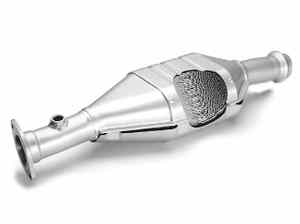What does a catalytic converter do?
Your exhaust produces harmful emissions of hydrocarbons, carbon monoxide and nitrogen oxides that are damaging to the atmosphere if released into the air.
A catalytic converter substantially reduces the amount of harmful pollutants by taking these gases and converting them into water vapour and less harmful gases via a series of chemical reactions. All petrol cars manufactured since 1993 must have a catalytic converter fitted to the exhaust.
How does a catalytic converter work?
The catalytic converter includes a core of ceramics riddled with pores that measure less than 1mm. The pores are coated with powdered catalysts that contain metals such as platinum, palladium and rhodium. Because the pores are close to the engine they heat up and the chemical structure of the exhaust gases passing though it changes so that harmful gases that cause smog are removed and converted into nitrogen and oxygen.

Carbon monoxide and hydrocarbons are broken down and converted into carbon dioxide and water. Catalytic converters are so efficient that the difference in emission readings for cars with converters and those without are considerable. The good news is that catalytic converters have a good life expectancy, but still need to be checked periodically for internal and external damage.
Catalytic converter problems
Catalytic converter issues can lead to increased exhaust emissions and a decrease in engine performance. Most issues stem from temperature changes in the exhaust system. Excessive unburnt fuel in the exhaust can cause the catalyst to reach extremely high temperatures which can cause damage to the fine catalyst material. As a result, the catalytic converter becomes less effective, less chemical conversions take place and the exhaust output contains more harmful gases.
Similarly, rapid cooling of the catalytic converter, such as by being submerged in water, can cause the internal honeycomb structure to break apart and obstruct the exit to the exhaust pipe. If the catalytic converter becomes plugged, engine efficiency will decrease noticeably.
If you are at all concerned about the performance of your catalytic converter, call into your nearest Kwik Fit for a free exhaust check.
Lambda Sensor and ECU
Another device that helps to reduce carbon emissions is the oxygen or lambda sensor. This monitors the percentage of oxygen present in exhaust gases and transmits information to the engine management system or electronic control unit (ECU).
The ECU utilises information obtained from the oxygen sensor and constantly adjusts the air/fuel mixture so that the cleanest and most efficient combustion is achieved under all operating conditions. The oxygen sensor, catalytic converter and ECU all work together to help to achieve the lowest possible output of dangerous and polluting gases.
Sometimes, a failed catalytic converter can be due to a fault in the engine management system or lambda sensor. At Kwik Fit our trained exhaust technicians will perform a full inspection of your exhaust system and, by using the latest specialist diagnostic equipment; well help to identify the cause of the problem to prevent further damage.




